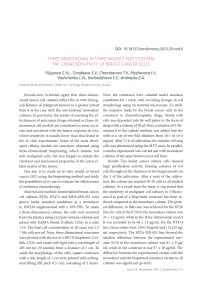Three-dimensional in vitro models for studying the chemosensitivity of breast cancer cells
Автор: Filippova S.Yu., Timofeeva S.V., Chembarova T.V., Mezhevova I.V., Vashchenko L.N., Kechedzhieva E.E., Andreyko E.A.
Журнал: Cardiometry @cardiometry
Рубрика: Conference proceedings
Статья в выпуске: 29, 2023 года.
Бесплатный доступ
Scientists agree that three-dimensional tumor cell cultures reflect the in vitro biological features of malignant tumors to a greater extent than it is the case with the conventional monolayer cultures. In particular, the results of assessing the effectiveness of anticancer drugs obtained in three-dimensional cell models are considered as more accurate and consistent with the tumor response in vivo, where sensitivity is usually lower than that found in the in vitro experiments. Some of the most developed cellular models are structures obtained using three-dimensional bioprinting, which include not only malignant cells, but also biogels to imitate the chemical and mechanical properties of the extracellular matrix of the tumor.
Breast cancer, bioink, bioprinting, 5-fluorouracil
Короткий адрес: https://sciup.org/148327378
IDR: 148327378 | DOI: 10.18137/cardiometry.2023.29.conf.6
Текст статьи Three-dimensional in vitro models for studying the chemosensitivity of breast cancer cells
National Medical Research Centre for Oncology, Rostov-on-Don, Russia
Introduction : Scientists agree that three-dimensional tumor cell cultures reflect the in vitro biological features of malignant tumors to a greater extent than it is the case with the conventional monolayer cultures. In particular, the results of assessing the effectiveness of anticancer drugs obtained in three-dimensional cell models are considered as more accurate and consistent with the tumor response in vivo, where sensitivity is usually lower than that found in the in vitro experiments. Some of the most developed cellular models are structures obtained using three-dimensional bioprinting, which include not only malignant cells, but also biogels to imitate the chemical and mechanical properties of the extracellular matrix of the tumor.
Our aim is to create an in vitro model of breast cancer (BC) using the bioprinting method and study the possibilities of its use to evaluate the effectiveness of antitumor chemotherapy.
Material and methods : Immortalized breast cancer cell cultures BT20, BT474 and MDA-MB-453 were grown under standard conditions as a monolayer in DMEM supplemented with a 10% FBS. To create a three-dimensional culture, the cells were removed from the plastics using a trypsin-versene solution and mixed with GelMA bioink (Cellink, USA) in a ratio 1:10. The final cell concentration in all cases was 2.5 * 106 cells per ml. Next, three-dimensional structures were printed with the use of a BIO X bioprinter (Cellink, USA) and cured with light with a wavelength of 405 nm for 20 seconds from a distance of 5 cm. To study the morphology of the cells, square constructs with a side length of 1 cm were printed with orthogonal filling (fill pitch 0.5 cm), consisting of 3 layers.
Next, the constructs were cultured under standard conditions for 1 week, with recording changes in cell morphology using an inverted microscope. To study the response made by the breast cancer cells in the constructs to chemotherapeutic drugs, bioink with cells was deposited into 96-well plates in the form of drops with a volume of 50 μl. Next, a solution of 5-flu-orouracil to the culture medium was added into the wells in a set of two-fold dilutions from 10-1 to 10-4 mg/ml. After 72 h of cultivation, the number of living cells was determined using the MTT assay. In parallel, a similar experiment was carried out with monolayer cultures of the same breast cancer cell lines.
Results : The breast cancer culture cells showed high proliferative activity, forming colonies of 4-8 cells throughout the thickness of the biogel already on day 3 of the cultivation. After a week of the cultivation, the colony size reached 30-50 cells in all studied cultures. As a result from the study, it was found that the sensitivity of malignant cell cultures to 5-fluoro-uracil as part of a bioprinted construct has been reduced compared to the monolayer culture. The greatest difference, in that case, was achieved for the BT20 line, for which the IC50 in the monolayer culture was 35 ± 12 μg/ml, while in the three-dimensional model it was recorded to be 64 ± 15 μg/ml. For the BT474 line, those values were 110±19 μg/ml and 131±25 μg/ ml, respectively. The MDA-MB-453 line showed the smallest difference between the experimental variants: IC50 in the monolayer culture was 81 ± 9 μg/ ml, while in the construct it was 97 ± 10 μg/ml. The difference between the experimental variant with the monolayer and the bioprinted construct variant in all cultures was significant (p<0.01).


